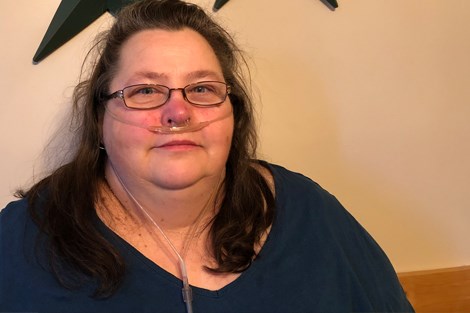In 2000, after a trip to her camp at Mattagami Lake, Connie Leroy starting experiencing pain in her chest.
“I had a sharp pain to the lower right side of my chest,” says Leroy. “Without testing, the doctor sent me home saying, ‘Take it easy, you have a pulled muscle'.”
“A few days later I went back,” says Leroy. “I had the same jabbing pain, but with a fever and sweating. This time, they took x-rays and blood work and said I had pneumonia.”
Leroy says she took the antibiotics the doctor gave her, but they didn’t help.
“A few days more and I was getting worse,” says Leroy. “I could barely breathe, could hardly move, was really sweating. I went back to the hospital where I was brought in right away.”
“My blood oxygen level was 42 per cent,” says Leroy. “The average person is at 98 per cent. I also had a fever of about 105 or 106 degrees.”
Leroy says she was airlifted a couple of days later to Toronto General where she underwent a bronchoscopy to take a lung sample. The results showed she had a rare illness known as Blastomycosis.
According to the Centres for Disease Control and Prevention (CDC), Blastomycosis (Blasto for short) is an infection caused by the fungus Blastomyces. Someone can contract the infection from “breathing in the microscopic fungal spores from the air.” Blasto is diagnosed rarely, with one to two cases per 100,000 people reported each year.
A small outbreak of the infection in the Sudbury area last year resulted in the hospitalization and treatment of several children, prompting the Sudbury and District Health Unit to issue an advisory.
Incidences like these may be raising awareness today, but Leroy says when she first contracted Blasto in 2000, her doctors didn’t know what it was.
“I was misdiagnosed three times by two different hospitals,” Leroy says.
“Because it took so long to diagnose me, it spread to both lungs,” Leroy says. “I was told it takes an antifungals not antibiotics to take it away.”
Leroy says she was on strong medications for more than a year and in and out of the hospital, but even after that, her life was still “drastically changed.”
“I now have restrictive lung disease because of the damage to both lungs,” says Leroy, now 52. “The more I move, the more my oxygen goes down. This is the third time I’m on oxygen. The first two times was for three months each time. This time it’s been a year and a half.”
“I so love to dance and sing and take walks. I can’t do any of that anymore. It really breaks my heart and sometimes I cry. Then I say, ‘I’m still alive so that’s what counts'.”
Leroy says her struggles have affected her family, too.
“My family and close friend worry on a daily basis and it’s been 17 years since I was cleared of Blasto,” says Leroy. “My family constantly asks how I’m doing.”
It turns out that Leroy is not alone in her struggle.
“I’m on a Facebook support group for across Canada and the U.S.A,” says Leroy. “We are all different. Some have bounced back better than others.”
Now, she’s spreading the word in the hopes that others can catch the disease before it progresses as far as hers did.
“Blasto is a silent disease,” says Leroy. “You don’t know you breathe it in, you don’t know when or where you breathe it in. It can kill easily if not found. People need to be aware.”
“I try to spread the word,” says Leroy. “I tell it to anyone who will listen.”



